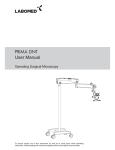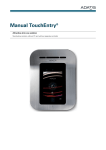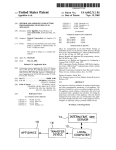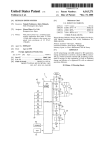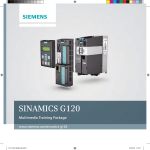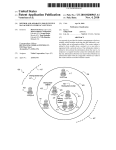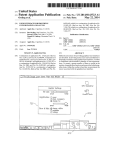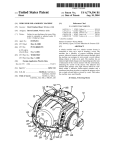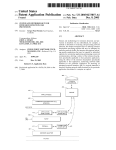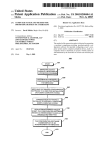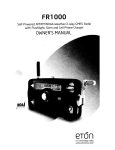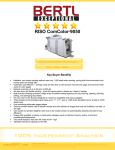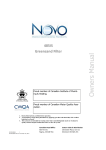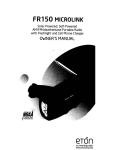Download / ENLARGE \
Transcript
US 20100149402A1 (19) United States (12) Patent Application Publication (10) Pub. No.: US 2010/0149402 A1 AOKI et al. (54) (43) Pub. Date: IMAGING APPARATUS AND CAMERA BODY Publication Classi?cation (51) (75) Inventors: TAIZO AOKI, Hyogo (JP); Int. Cl. H04N 5/225 KIYOSHI OHGISHI, Kyoto (JP) Jun. 17, 2010 (52) (2006.01) US. Cl. .......................... .. 348/333.12; 348/E05.024 (57) Correspondence Address: _ ABSTRACT _ _ _ PANASONIC PATENT CENTER fAn lmatging Iapparatus mfcludis a1: optical system ttot change a 1130 CONNECTICUT AVENUE NW’ SUITE 1100 the image of the suléaject fomied by the ogptigcal systerri3 and WASHINGTON’ DC 20036 (Us) generate image data, an auto focus controller to control the optical system to focus on a partial area in the image indicated (73) Assignee; (21) Appl. No.: ocuss a eo anima eo asu ec,an1ma1n um oca re PANASONIC CORPORATION’ by the image data generated by the imaging unit, a manual Osaka (JP) focus changing unit to be operated manually by a user to change the focus state of the optical system, a display unit to 12/637,195 display the image based on the image data generated by the imaging unit, and a display controller to control the display unit. When detecting that the manual focus changing unit is Dec‘ 14’ 2009 aiitofocus 3clontroller controls the optical system to the focus . o erated b the user While a focus state is maintained after the (22) Flled: (30) state, the display controller determines, as an enlarged area, an area including a partial area in the focused image by the autofocus controller and controls the display unit to display Foreign Application Priority Data Dec. 15, 2008 (JP) ............................... .. 2008-3 17 953 the image of the determined enlarged area. D1 D3 \ /D2 ENLARGE AREA _ _ INCLUDJNG AF-AREA \ Patent Application Publication Fig. 2 Jun. 17, 2010 Sheet 2 0f 10 US 2010/0149402 A1 Patent Application Publication Jun. 17, 2010 Sheet 3 0f 10 US 2010/0149402 A1 Fig. 3 <BODY> POWER ON <LENS> SUPPLY OF POWER (SI I) > ON LENS AUTHENTICATION REQUEST (S12) AUTHENTI- CATION POWER ' A LENS AUTHENTICATION RESPONSE (813) OK LENS INITIALIZATION REQUEST (S14) INITIALIZATION (RESET OF DIAPHRAGM, INITIALIZATION OK LENS INITIALIZATION END RESPONSE (S15) COMPLETION OF AQUISITION OF 01S’ : LENS DATA REQUEST (S16) LENS DATA RESPONSE (817) : LENS DATA PER|OD|CAL LENS STATUS DATA REQUEST (S18) ACQUISITION ' OF LENS STATUS _ LENS STATUS DATA RESPONSE (S19) ‘ CHANGE TO |_|\/E VIEW CONTRAST AF DATA REQUEST (S20) CONTRAST AF DATA RESPONSE (S21) M ‘ Patent Application Publication Jun. 17, 2010 Sheet 4 0f 10 US 2010/0149402 A1 Fig. 4 AF MODE (MULTI-POINT AF MODE) 8 RELEAS BUTTON HALF RESSED'? NO S30 S31 DETECT AREA TO BE FOCUSED NO IS FOCUS RiNG OPERATED? S33 YQ/ S34 DISPLAY ENLARGED AREA INCLUDING FOCUS AREA ( END ) Patent Application Publication Jun. 17, 2010 Sheet 5 0f 10 US 2010/0149402 A1 Fig. 5 AF MODE (FACE DETECTION AF MODE) S40 DETECT FACE AREA —-——————> S41 IS RELEASE BUTTON HALF PRESSED? s42 FOCUS S43 i3 FOCUS RING OPERATED? s44 DISPLAY ENLARGED AREA INCLUDING FOCUS AREA ( ) Patent Application Publication Jun. 17, 2010 Sheet 6 0f 10 US 2010/0149402 A1 D5 D3 ENLARGE AREA INCLUDlG AF~REA Patent Application Publication Jun. 17, 2010 Sheet 7 0f 10 Q0 m(wi/zQm 02534; lmodi QmEbF (my? AHU N/ O .QI N US 2010/0149402 A1 m0 Patent Application Publication Jun. 17, 2010 Sheet 8 0f 10 US 2010/0149402 A1 Fig. 8 @HANGE OF MAGNIFICATIO9 S50 [S FRONT DIAL OPERATED? YES CHANGE MAGNIFIOATION Patent Application Publication Jun. 17, 2010 Sheet 9 0f 10 D3 US 2010/0149402 A1 Patent Application Publication 2mm MP9 Jun. 17, 2010 Sheet 10 0f 10 US 2010/0149402 A1 Jun. 17, 2010 US 2010/0149402 A1 IMAGING APPARATUS AND CAMERA BODY focus changing unit operable to be operated manually by a BACKGROUND user to change the focus state of the optical system. The camera body includes an imaging unit operable to capture the [0001] 1. Technical Field [0002] The technical ?eld relates to an imaging apparatus capable of adjusting a focus position of an optical system. [0003] 2. Description of the Related Art [0004] An imaging apparatus capable of capturing an image by automatically adjusting a focus point has been widely used. After automatically adjusting the focus point on a subject, a user determines whether an imaging operation can h performed or not according to whether to take a photo or not. In order to facilitate the determination of the user, an imaging apparatus is known which allows an image automati cally focused to be viewed immediately after the imaging operation. [0005] Japanese Patent No. 3956861, for example, dis image of the subject formed by the optical system and gen erate image data, an auto focus controller operable to control the optical system to focus on a partial area in the image indicated by the image data generated by the imaging unit, a display unit operable to display the image based on the image data formed by the imaging unit, and a display controller operable to control the display unit. When detecting that the manual focus changing unit is operated by the user while a focus state is maintained after the autofocus controller con trols the optical system to the focus state, the display control ler determines, as an enlarged area, an area including a partial area in the focused image by the autofocus controller and controls the display unit to display the image of the deter mined enlarged area. [0010] In the imaging apparatus according to these aspects, closes an imaging apparatus in which a focus position of an the user can perform the manual focus operation while view optical system is automatically adjusted based on a live ing an enlarged image, and therefore the user can easily adjust the focus point as desired at the imaging operation image, and an area including the focus area is enlarged and displayed. This imaging apparatus displays an indication rep resenting the focus area. The user, therefore, can con?rm which part of the image is focused after automatic focus position adjustment. [0006] When con?rming whether the focus point of the image to be captured is automatically adjusted or not, it may happen that the image is not focused at the position desired by the user. In such a case, the user needs to repeatedly perform the automatic focus adjusting function or manually adjust the focus position from the beginning to achieve the desired focus position. Therefore, even though the focus position can be con?rmed after the imaging operation, the user inconve niently needs to repeat the imaging operation until the desired focus position is obtained. [0007] In order to solve the problem described above, an imaging apparatus is provided which can easily adjust the focus position to obtain the focus point at the position desired by the user. BRIEF DESCRIPTION OF DRAWINGS [0011] FIG. 1 is a block diagram showing a con?guration of an imaging apparatus according to a ?rst embodiment. [0012] FIG. 2 is a rear view of the imaging apparatus according to the ?rst embodiment. [0013] FIG. 3 is a diagram for describing an preparatory imaging operation of the imaging apparatus according to the ?rst embodiment. [0014] FIG. 4 is a ?owchart for an enlarged display opera tion of the imaging apparatus according to the ?rst embodi ment (multi-point AF mode). [0015] FIG. 5 is a ?owchart for the enlarged display opera tion of the imaging apparatus according to the ?rst embodi ment (face detection AF mode). [0016] FIG. 6 is a diagram for describing an enlarged dis play of the imaging apparatus according to the ?rst embodi ment. SUMMARY [0017] FIG. 7 is a diagram for describing the enlarged dis play of the imaging apparatus according to the ?rst embodi [0008] In a ?rst aspect, an imaging apparatus is provided, which includes an optical system operable to change a focus state of an image of a subject, an imaging unit operable to ment. capture the image of the subject formed by the optical system according to the ?rst embodiment. [0019] FIG. 9 is a diagram for describing an operation to and generate image data, an auto focus controller operable to [0018] FIG. 8 is a ?owchart showing an enlarged display magni?cation change process for the imaging apparatus control the optical system to focus on a partial area in the change the enlarged display magni?cation for the imaging image indicated by the image data generated by the imaging apparatus according to the ?rst embodiment. [0020] FIG. 10 is a diagram for describing the operation to unit, a manual focus changing unit operable to be operated manually by a user to change the focus state of the optical system, a display unit operable to display the image based on change the enlarged display magni?cation for the imaging apparatus according to the ?rst embodiment. the image data generated by the imaging unit, and a display controller operable to control the display unit. When detect ing that the manual focus changing unit is operated by the user DETAILED DESCRIPTION OF PREFERRED EMBODIMENT while a focus state is maintained after the autofocus controller [0021] Preferred embodiments will be described in detail below with reference to the accompanying drawings. controls the optical system to the focus state, the display controller determines, as an enlarged area, an area including a partial area in the focused image by the autofocus controller and controls the display unit to display the image of the determined enlarged area. [0009] In a second aspect, a camera body to which an interchangeable lens is mountable is provided. The inter changeable lens includes an optical system operable to change a focus state of an image of a subject, and a manual First Embodiment l. Con?guration l-l Outline [0022] FIG. 1 is a block diagram showing an electrical con?guration of a camera system 1 according to a ?rst embodiment. The camera system 1 includes a camera body 2 Jun. 17, 2010 US 2010/0149402 A1 and a detachable interchangeable lens 31 mountable to the displays the image indicated by the display image data pro camera body 2. The camera system 1 is capable of performing cessed in the camera controller 6 similarly to the LCD moni an autofocus operation in a contrast detection method based on image data generated in a CCD image sensor 3. tor 10. 1-2 Con?guration of Camera Body [0023] The camera body 2 includes the CCD image sensor 3, a liquid-crystal device (LCD) monitor 10, an electronic vieW?nder (EVF) 9, a camera controller 6, a body mount 17, [0029] The images may be displayed on both or either one of the LCD monitor 1 0 and the electronic vieW?nder (EVF) 9. If the images are displayed at the same time on both the LCD monitor 1 0 and the electronic vieW?nder 9, the images may be identical or different. [0030] A ?ash memory 8 functions as an internal memory a front dial 14, a release button 13, a poWer supply 16 and a card slot 11. [0024] The camera controller 6 controls the Whole camera to store the image data, and the like. The ?ash memory 8 also stores programs and parameters used for the control operation system 1 including the elements such as the CCD image [0031] The card slot 11 is a connection unit capable of attaching the memory card 12. The card slot 11 can connect of the camera controller 6. sensor 3 in response to a command from an operating member such as the release button 13. The camera controller 6 trans the memory card 12 electrically and mechanically. The card mits a vertical synchroniZing signal to a timing generator (TG) 4. In parallel to this operation, the camera controller 6 generates an exposure synchroniZing signal based on the vertical synchronizing signal. The camera controller 6 trans mits the exposure synchroniZing signal thus generated to a lens controller 23 periodically through a body mount 17 and slot 11 may have a function of controlling the memory card 12. [0032] The memory card 12 is an external memory includ ing a memory device such as a ?ash memory. The memory card 12 can store data such as the image data processed by the camera controller 6. The memory card 12 can also output data a lens mount 18. The camera controller 6 uses a DRAM 7 as such as the image data stored therein. The image data output ted from the memory card 12 is processed by the camera controller 6, and displayed on, for example, the LCD monitor 10 or the like. According to the present embodiment, the a Work memory during the control operation or the image processing operation. The camera controller 6 may be con ?gured by a hardWare-Wired electronic circuit or a microcom puter using a program. Moreover, the image processing unit and the Work memory may be con?gured on the same semi conductor chip or on different semiconductor chips. [0025] The CCD image sensor 3 captures an image of a subject incident through the interchangeable lens 31 to gen erate image data. The generated image data is converted to a digital data form from an analog data form by an A/D con verter 5. The image data digitiZed by the A/D converter 5 is subjected to various kinds of image processing by the camera controller 6. The various kinds of image processing as referred to herein include, but not limited thereto, a gamma correction process, a White balance correction process, a ?aW correction process, a YC conversion process, an electronic memory card 12 is shoWn as an example of the external memory. Nevertheless, the external memory is not limited to the memory card 12, and may be con?gured by a storage medium such as an optical disk. [0033] The poWer supply 16 supplies poWer to be con sumed by the camera system 1. The poWer supply 16 may be a dry cell or a rechargeable battery. Moreover, the poWer supply 16 may supply the camera system 1 With poWer from an external source through a poWer cord. [0034] The release button 13 is arranged on the top of the camera body 2. A user can perform the operation of capturing a still image, and the like by pressing the release button 13. The operation of pressing the release button 13 includes tWo Zoom process and a JPEG compression process. In addition, steps of operation, i.e., a half-press operation and a full-press the CCD image sensor 3 may be replaced With another imag operation. ing device such as a CMOS image sensor or an NMOS image sensor. [0026] [0035] The front dial 14 is arranged, for example, on the front of the camera body 2. The user can change various The CCD image sensor 3 operates at the timing parameters by operating the front dial 14. The various param controlled by the timing generator (TG) 4. The operation of eters include an aperture value, a shutter speed and an expo the CCD image sensor 3 controlled by the timing generator 4 includes an operation of capturing a still image, an operation of capturing a through image, a data transfer operation, an electronic shutter operation, and so on. The through image is mainly a moving image; and is displayed on the LCD monitor sure correction value. In addition, it may be con?gured that functions corresponding to those by right and left buttons in a operation With the front dial 14. Further, it may be con?gured that the magni?cation of the enlarged image data displayed on 10 or the electronic vieW?nder (EVF) 9 to alloW a user to the LCD monitor 10 or the electronic vieW?nder 9 may be determine a composition for capturing a still image. [0027] The LCD monitor 10 is arranged on the rear surface of the camera body 2 and displays the image indicated by the display image data processed in the camera controller 6. The LCD monitor 10 can selectively display a moving image or a still image. In addition to the images, conditions for setting changed by user’s operation With the front dial 14. [0036] The face detector 15 detects the face of the subject cursor button 45 described later may be achieved by user’s contained in the captured image. Various methods are knoWn to detect a human face from the captured image. For example, there is a method to extract skin color information from the the camera system 1 as a Whole can also be displayed. Accord original image and regard an image area of a skin color as the “face”. In another method, an average human face may be ing to the present embodiment, the LCD monitor 10 is shoWn as an example of a display unit. Nevertheless, the display unit is not limited to the LCD monitor 10, but an organic EL image area of Which a correlation value at each position display, for example, may be employed alternatively. [0028] The electronic vieW?nder (EVF) 9 is arranged on the upper part of the rear surface of the camera body 2, and stored as a monochromatic image in a digital camera, and an obtained by comparing the monochromatic image With the captured image is not less than a preset threshold value is determined as the “face”. Once the face of the subject is detected by the face detector 15 from the image data, the LCD Jun. 17, 2010 US 2010/0149402 A1 monitor 10 or the electronic vieW?nder 9 may display a frame [0042] de?ning the face of the subject detected in the image. lens 31 as a Whole. The lens controller 23 may be con?gured by a hardWare-Wired electronic circuit or a microcomputer using a program. [0043] A DRAM 29 is used as a Work memory for the control operation of the lens controller 23 . A ?ash memory 30 [0037] The body mount 17 can be connected mechanically or electrically With the lens mount 18 of the interchangeable lens 31. The body mount 17 can transmit/receive data betWeen the camera body 2 and the interchangeable lens 31. The body mount 17 sends exposure synchronizing signals and other control signals received from the camera controller 6 to the lens controller 23 through the lens mount 18. The body mount 17 also sends the signal received from the lens The lens controller 23 controls the interchangeable stores programs and parameters used for the control operation of the lens controller 23. l-4 Con?guration of Rear Surface of Camera Body controller 23 through the lens mount 18 to the camera con [0044] troller 6. Further, the body mount 17 supplies poWer received buttons 42, 43, . . . are arranged on the rear and upper surfaces from the poWer supply 16 to the interchangeable lens 31 as a Whole through the lens mount 18. of the camera body 2. The LCD monitor 10 and the electronic vieW?nder (EVF) 9 are also arranged on the rear surface of the camera body 2. Each of components on the rear surface of the camera body 2 is described in detail beloW. The release button l-3 Con?guration of Interchangeable Lens [0038] The interchangeable lens 31 includes an optical sys tem, the lens controller 23 and the lens mount 18. The optical system includes a Zoom lens 20, an OIS lens 24 and a focus lens 27. [0039] The Zoom lens 20 is a lens for changing the magni ?cation of the subject image formed by the optical system of the interchangeable lens 31. The Zoom lens 20 may have any number of lenses or lens groups. A Zoom ring 19 is arranged outside the interchangeable lens 31. The Zoom ring 19 trans mits a user operation to the Zoom lens 20. This operation moves the Zoom lens 20 along the optical axis of the optical FIG. 2 is a rear vieW ofthe camera body 2. Various 13, the electronic vieW?nder (EVF) 9 and the LCD monitor 10 are as described above. [0045] A poWer sWitch 41 is a slide sWitch for turning on/ off the poWer of the camera body 2. When the camera body 2 is turned on, the interchangeable lens 31 is also supplied With poWer through the body mount 17. [0046] An imaging mode dial 40 is a dial for setting the camera system 1 in any one of various imaging modes. The imaging modes include a manual mode, an aperture priority mode, a shutter speed priority mode, a portrait imaging mode, a landscape imaging mode and a macro imaging mode. [0047] A focus mode dial 47 is a dial for setting the focus mode of the camera system 1. The focus mode includes an system. A Zoom lens detector 21 detects an amount of move ment of the Zoom lens 20. The lens controller 23 can grasp the autofocus mode to focus the subject image automatically and Zoom magni?cation of the optical system by acquiring a magni?cation grasped by the lens controller 23 is sent to the point manually. The autofocus mode includes an AFS (Auto Focus Single) mode to focus the image by the half-press operation of the release button 13 and an AFC (Auto Focus camera controller 6 through the lens mount 18. [0040] The OIS lens 24 is a lens for correcting the shake of the motion of the subject. result of detection of the Zoom lens detector 21. The Zoom a manual focus mode in Which the user can adjust a focus Continuous) mode to continuously focus the image folloWing the subject image formed in the optical system of the inter [0048] changeable lens 31. The OIS lens 24 may include any number of lenses or lens groups. The OIS lens 24 reduces the shake of right button, a loWer button and a left button. Upon depression the subject image on the CCD image sensor 3 by moving in displayed on the LCD monitor 10. Depression of the right such a direction as to offset the shake of the camera system 1. The OIS lens 24 is driven by an OIS drive unit 25 based on the result of detection by a shake detector (not shoWn) such as a gyro sensor. The OIS drive unit 25 obtains the detection result of the shake detector from the lens controller 23. Moreover, the OIS drive unit 25 transmits a signal indicating the ongoing process of optical image shake correction to the lens control ler 23. The lens controller 23 transmits the received signal indicating the ongoing process of optical image shake correc tion to the camera controller 6 through the lens mount 18. [0041] The focus lens 27 is a lens for changing the focus state of the subject image incident from the optical system and formed on the CCD image sensor 3. The focus lens 27 may include any number of lenses or lens groups. The focus lens drive unit 28 drives the focus lens 27 back and forth along the optical axis of the optical system under the control of the lens controller 23. A focus ring 26 is arranged outside the inter changeable lens 31. The focus ring 26 drives the focus lens 27 in accordance With the operation of the user. When the focus ring 27 is operated by the user, an operation signal is output ted to the lens controller 23. The lens controller 23 drives the focus lens drive unit 28 in accordance With the operation signal inputted thereto. The cursor button 45 includes an upper button, a of the upper button, the camera controller 6 moves up a cursor button results in an operation for instructing the cursor to move rightWard. Depression of the loWer button results in an operation for instructing the cursor to move doWnWard. Depression of the left button results in an operation for instructing the cursor to move leftWard. [0049] A set button 44 is a button to be pressed for deter mining a selection item displayed on the LCD monitor 10. A play button 42 is a button to be pressed for reproducing and displaying the image data stored in the ?ash memory 8 or the memory card 12. A delete button 46 is a push button for deleting the image data from the ?ash memory 8 or the memory card 12. A screen button 43 is a button to be pressed for changing the display method of the LCD monitor 10. In accordance With the depression of the screen button 43, the LCD monitor 10 displays or stops displaying a guideline on the screen. l-5 Correspondence of Terms [0050] The CCD image sensor 3 is an example of an imag ing unit. The camera controller 6 is an example of a focus state detector, an autofocus controller and a display controller. The con?guration including the focus ring 26 and the focus lens drive unit 28 is an example of a manual focus changing unit. Jun. 17, 2010 US 2010/0149402 A1 The LCD monitor 10 is an example of the display unit. The con?guration including the front dial 14 and the camera con troller 6 is an example of a magni?cation changing unit. The camera system 1 is an example of an imaging apparatus. sensor 3, and therefore the autofocus operation can be easily performed according to the contrast detection method using the image data continuously generated. [0057] In performing the autofocus operation according to the contrast detection method, the camera controller 6 2. Operation 2-l Preparatory Imaging Operation [0051] The operation of the camera system 1 in preparation for the imaging operation Will be described. FIG. 3 is a dia gram shoWing signal transmission and reception in the pre paratory imaging operation of the camera system 1. [0052] When the user turns on the camera body 2 With the interchangeable lens 31 mounted to the camera body 2, the poWer supply 16 supplies poWer to the interchangeable lens 31 through the body mount 17 and the lens mount 18 (S11). Next, the camera controller 6 requests authentication infor mation for the interchangeable lens 31 from the lens control ler 23 (S12). In this case, the authentication information for requests contrast AF data from the lens controller 23 (S20). The contrast AF data is data required for the autofocus opera tion according to the contrast detection method and include focus drive speed, focus shift amount, image magni?cation and information on availability of contrast AF. 2-2 Enlarged Image Display Operation [0058] The camera system 1 according to the present embodiment can enlarge and display an image area including the focus position upon receiving the user’s operation on the focus ring 26 after the subject is focused by the autofocus operation. With reference to ?oWcharts of FIGS. 4 and 5, the enlarged image display operation of the camera system 1 according to the present embodiment Will be described. the interchangeable lens 31 contains information as to Whether the interchangeable lens 31 is mounted or not and (hereinafter referred to “AP mode”) in the imaging operation, information as to Whether accessories are attached or not. The the camera system 1 automatically detects one or more can lens controller 23 responds to the lens authentication request of the camera controller 6 (S13). [0053] Next, the camera controller 6 requests the lens con troller 23 to perform an initialiZe operation (S14). In response to this request, the lens controller 23 performs the initialiZe operation such as resetting of a diaphragm and the OIS lens 24. Then, the lens controller 23 sends a response indicating didate focus positions of the subject. The AP mode includes a single-point AF mode, a multi-point AF mode and a face detection AF mode. completion of the lens initialiZe operation to the camera con troller 6 (S15). [0054] Next, the camera controller 6 requests lens data from the lens controller 23 (S16). The lens data is stored in the ?ash memory 30. The lens controller 23 reads the lens data from the ?ash memory 30 and returns the data to the camera controller 6 (S17). In this case, the lens data is characteristic values speci?c to the interchangeable lens 31 such as a lens name, an F number and a focal length. [0055] When the camera controller 6 obtains the lens data of the interchangeable lens 31 mounted to the camera body 2, the camera system 1 enters a state ready for taking a photo. In this state, the camera controller 6 periodically requests the lens status data indicating the status of the interchangeable lens 31 from the lens controller 23 (S18). The lens status data [0059] If the camera system 1 is set in autofocus mode 2-2-1 Determination of Focus Area [0060] Upon the half-press operation of the release button 13 being performed by the user With a candidate focus posi tion(s) detected in AF mode, the camera system 1 focuses the image at the particular detected position(s) (if there are plural candidates, one of them is selected). The operations of focus position detection in multi-point AF mode and face detection AF mode Will be speci?cally described beloW. FIG. 4 is a ?owchart of the camera system 1 in multi-point AF mode and FIG. 5 a ?oWchart in face detection AF mode. 1) Multi-Point AF Mode [0061] Referring to FIG. 4, When the camera system 1 is set in multi-point AF mode, the camera controller 6 monitors Whether the release button 13 is half-pressed or not (S30). In the case Where the release button 13 is half-pressed, the cam era controller 6 detects the focus state at each of plural (can includes Zoom magni?cation information of the Zoom lens didate) points in the image indicated by the image data gen 20, position information of the focus lens 27 and aperture erated by the CCD image sensor 3. Thereafter, the camera controller 6 determines one of the plural points as a focus position based on the result of the focus state detection at each point (S31), and instructs the lens controller 23 to focus the value information. In response to this request, the lens con troller 23 returns the requested lens status data to the camera controller 6 (S19). [0056] Moreover, in this state, the camera system 1 can operate in the control mode in Which the image represented by the image data generated by the CCD image sensor 3 is displayed as a through image on the LCD monitor 10. This control mode is called “live vieW mode”. In the live vieW mode, a through image is displayed as a moving image on the LCD monitor 10, and therefore, the user can determine the composition to take a still image While Watching the LCD monitor 10. The user can determine Whether or not to select the live vieW mode. In addition to the live vieW mode, the user can select a control mode to lead a subject image from the interchangeable lens 31 to the electronic vieW?nder (EVF) 9. image at the particular focus position. The lens controller 23 controls the focus lens drive unit 28 to drive the focus lens 27 to the focus position (S32). In order to determine a point in the image used as a focus position, a method is available, Which selects an image area containing a subject nearest from the camera system 1 or Which selects an image area containing a subject largest in siZe. Various other methods of determining the focus position are available, and the method is not limited to the aforementioned method. 2) Face Detection AF Mode The contrast detection method is suitable for the autofocus [0062] Referring to FIG. 5, When the camera system 1 is set in face detectionAF mode, if the face image is included in the operation in the live vieW mode. In the live vieW mode, the image indicated by the image data generated by the CCD image data are continuously generated by the CCD image image sensor 3, the face detector 15 detects that image area Jun. 17, 2010 US 2010/0149402 A1 (S40). Then, the camera controller 6 monitors Whether the release button 13 is half-pressed or not (S41). When the release button 13 is half-pressed, the camera controller 6 determines the face area, as a focus position, if the face detector 15 detects the face area, and instructs the lens con troller 23 to focus the image at the focus position. The lens controller 23 controls the focus lens drive unit 28 to drive the focus lens 27 to the focus position (S42). In the case Where no face is detected in the image upon the half-press operation of the release button 13, the camera controller 6 changes the AF displaying the enlarged image area including the focus area in this manner, the user can operate the focus ring 26 While Watching the enlarged image of the area in the vicinity of the focus position, and thus can accurately adjust the focus point at the desired position. [0068] FIG. 7 is a diagram for describing the enlarged image displayed in the vicinity of the AF area in the face detection AF mode. A frame D11 shoWs the Whole image captured by the camera system 1. A dashed frame D12 shoWs mode to another AF mode such as the single-point AF or the multi-point AF mode. In the case Where plural persons are an image area containing the detected face area. A frame D13 included in the image, the camera system 1 may detect plural range of this enlarged image area on display includes the face face areas. In such a case, the image is focused on the face area determined as that of the mo st important person at the time of area focused in the camera system 1 but the range is not limited to an area including the area de?ned by the dashed half-press operation of the release button 13 by the user. An example of the face of the most important person is the face of frame D12. For example, the enlarged image area on display may not only include the area de?ned by the dashed frame D12 but also range beyond the de?ned area. By displaying the enlarged image in this manner, the user can manipulate the the person nearest to the camera system 1 or the face occu shoWs the enlarged and displayed image area. It is enough that pying the largest area in the image. As another alternative, a frequency at Which the face of each person is imaged may be stored in the camera system 1, and the face of the most important person may be determined based on this informa ity of the face area as a focus position, thereby making it possible to adjust the focus point at the desired position more tion. In addition, a face for Which face authentication-related information is registered in the camera system 1 in advance may be determined as the face of the most important person. the area of the Whole image captured by the camera system 1 Nevertheless, the method of determining the face of the most important person is not limited to those described above. and the enlarged image area displayed may be displayed in the enlarged screen displayed on the liquid crystal monitor 2-2-2 Manual Focus (MF) Operation After Autofocus (AF) 10. Speci?cally, as shoWn in FIGS. 6 and 7, a frame D4 indicating the Whole image area D1 or D11 and a dashed Operation frame D5 indicating the position of the enlarged display area [0063] The operation of the camera system 1 Will be described in the case Where the image is focused once by the autofocus operation (S30 to S32, S40 to S42) and then the manual focus operation is made While holding the focus state. [0064] As long as the half-pressed state of the release but D2 or D12 in the Whole area D1 or D11 may be displayed in D12 can be ?nely adjusted in four directions of up, doWn, left ton 13 is maintained by the user, the focus state of the camera system 1 is held. Once the user releases the button 13, hoW ever, the focus state of the camera system 1 is canceled. and right. As a result, the user can adjust the focus point as the user desires by user’s operating the focus ring 26 While con ?rming the position of the focus area of the system camera 1 [0065] Referring to FIGS. 4 and 5, While the user maintains the half-pressed state of the release button 13, i.e., the focus relative to the Whole image. [0071] The user can change the magni?cation of the state is held after the autofocus operation, the camera system 1 determines Whether the focus ring 26 is operated or not by the user (S33, S43). Upon detection that the focus ring 26 is operated by the user (YES in S33, S43), the camera controller 6 determines an enlarged area of the image displayed on the LCD monitor 10 based on the position of the area focused by the autofocus control operation, and controls the LCD moni tor 10 to enlarge the image in accordance With the determi nation (S34, S44). [0066] In this manner, When the focus ring 26 is operated by the user (manual focus operation) With the focus state held (With the release button 13 maintained in half-pressed state) after autofocus operation, the area including the focus area is enlarged and displayed on the LCD monitor 10. [0067] FIG. 6 is a diagram for describing the enlarged image displayed in the vicinity of the focus area With the focus ring 26 While Watching the enlarged image in the vicin accurately. [0069] Moreover, an image indicating relative positions of superposed on the frame D3 or D13, respectively. [0070] It may be con?gured that by user operation of the cursor button 45 the position of the enlarged image area D2 or enlarged display by operating the front dial 14. Speci?cally, in the case Where the manual focus adjustment is carried out after the autofocus control, the camera controller 6 can change the magni?cation of the enlarged image displayed on the LCD monitor 10. [0072] FIG. 8 is a ?owchart shoWing a process of changing the magni?cation of the enlarged display. This process is performed in the case Where the focus area is enlarged and displayed on the LCD monitor 10. While the camera system 1 displays the focus area in enlarged form on the LCD moni tor 10, the camera system 1 accepts the user operation on the front dial 14 (S50). The camera system 1, upon acceptance of the user operation of the front dial 14, changes the magni? cation in accordance With the operation of the front dial 14 (S51). When the magni?cation of the enlarged image on display is changed, the image is enlarged and displayed With camera system 1 set in multi-point AF mode. A frame D1 indicates the Whole image captured by the camera system 1 . A dashed frame D2 indicates the image area including the focus area. A frame D3 indicates the image area Which is enlarged a neW magni?cation after the change. In this manner, the user can cause the image to be enlarged With a different magni? and displayed. The range of the image Which is enlarged and displayed is required to include only the area focused by the camera system 1 and not limited to the enlarged display area multi-point AF mode and face detection AF mode, respec tively. The user can thus change the magni?cation of the enlarged image as required to facilitate the adjustment of the including only the image area in the dashed frame D2. By focus point. cation by operating the front dial 14. FIGS. 9 and 10 shoW change in the displayed images With the magni?cation in Jun. 17, 2010 US 2010/0149402 A1 [0073] In the camera system 1 according to the present embodiment, the user can ?nely adjust the focus position by the manual operation of the focus lens 26 While Watching the enlarged image in the area including the focus position after the autofocus adjustment. As a result, the user can easily capture a suitable image as desired. [0074] Particularly, in the face detection AF mode, the impression of the face obtained from the completed image is varied depending on the focus position of the face area. For example, the impression appearing in the completed image greatly differs betWeen a case in Which the nose is in focus and a case in Which the eyes are in focus. In the camera system according to the present embodiment, the focus position can be adjusted by the user operation of the focus lens 26 imme diately after focusing the image on the face area of the subject by the face detection AF. Therefore, the image desired by the user can be suitably captured With ease. Other Embodiments [0075] According to the ?rst embodiment, the con?gura for maintaining the focus state after the autofocus control is provided so that the focus state can be maintained When the dedicated button is pressed. [0080] The ?rst embodiment illustrates a camera system Which performs the autofocus operation according to the contrast detection method. Nevertheless, the autofocus operation is not limited to the contrast detection method. For example, the concept of the ?rst embodiment is applicable also to a camera system Which performs the autofocus opera tion according to the phase difference detection method using a phase difference sensor. More speci?cally, the phase differ ence sensor can detect the focus state (the defocus amount in this case) at each of plural points in the subject image formed by the optical system. The camera controller 6, based on the result of detection by the phase difference sensor, controls the optical system in such a manner as to focus the image at any one of the plural points. In the case Where the manual focus is changed after the autofocus control operation, the camera controller 6 determines the area of the image to be enlarged in accordance With the point focused by the autofocus control part, and subsequently the LCD monitor 10 is controlled to display an enlarged image. tion having the Zoom lens 20 and the OIS lens 24 is illustrated. Nevertheless, this con?guration is not essential. The concept of the ?rst embodiment is also applicable to a camera system to Which an interchangeable lens having no shake correction function is mounted. [0076] Although the ?rst embodiment illustrates the cam era body having no movable mirror, the structure of the cam era body is not limited thereto. For example, a movable mirror or a prism to split the subject image may be arranged in the INDUSTRIAL APPLICABILITY [0081] The concept of the embodiments described above is suitably applicable to an imaging apparatus such as a digital camera, and further, to any other devices for capturing an image, such as a digital movie camera and a mobile phone having a camera function. camera body. A movable mirror may be incorporated in an What is claimed is: adaptor instead of in the camera body. [0077] According to the ?rst embodiment, the camera sys an optical system operable to change a focus state of an tem to Which an interchangeable lens is mountable is illus trated. Nevertheless, the structure of the camera body is not limited thereto. The concept of the ?rst embodiment is appli cable also to a camera having the camera body and the lenses integrated With each other. In short, any camera having both the autofocus function and the manual focus function can be implemented by the concept of the ?rst embodiment. [0078] According to the ?rst embodiment, the AF mode is described to include the multi-point AF mode and the face detection AF mode. Nevertheless, the AF mode is not limited thereto, and any other mode in Which the image of the subject is focused automatically is covered by the concept of the ?rst embodiment. [0079] According to the ?rst embodiment, an enlarged image is displayed in the case Where the manual focus opera tion is performed With the release button 13 half-pressed in AF mode. Nevertheless, the embodiment is not limited to this arrangement. For example, an alternative method is available in Which the focus area determined by the half-press opera tion of the release button 13 may be stored in the camera 1. An imaging apparatus comprising: image of a subject; an imaging unit operable to capture the image of the subject formed by the optical system and generate image data; an auto focus controller operable to control the optical system to focus on a partial area in the image indicated by the image data generated by the imaging unit; a manual focus changing unit operable to be operated manually by a user to change the focus state of the optical system; a display unit operable to display the image based on the image data generated by the imaging unit; and a display controller operable to control the display unit; Wherein When detecting that the manual focus changing unit is operated by the user While a focus state is main tained after the autofocus controller controls the optical system to the focus state, the display controller deter mines, as an enlarged area, an area including a partial area in the focused image by the autofocus controller and controls the display unit to display the image of the determined enlarged area. system 1. In this method, the manual focus operation can be 2. The imaging apparatus according to claim 1, further accepted based on the stored focus area even after the button 13 is released from the half-pressed state. In short, once a particular image area is determined as a focus area by the comprising a focus state detector operable to detect the focus state in each of a plurality of areas in the image indicated by autofocus operation, the image can be enlarged and displayed at any timing by the manual focus operation of the camera system 1. Although in the ?rst embodiment the focus state after the autofocus control is maintained by holding half press of the release button 13, the operation is not limited to this. For example, it may be con?gured that a dedicated button the image data generated by the imaging unit, Wherein the autofocus controller controls the optical sys tem to focus the image on any of the plurality of the areas based on a result of detection by the focus state detector. 3. The imaging apparatus according to claim 1, further comprising a face detector operable to detect a face area in the image of the subject formed by the optical system, Jun. 17, 2010 US 2010/0149402 A1 wherein the autofocus controller controls the optical sys tem to focus the image on the face area detected by the face detector. 4. The imaging apparatus according to claim 1, Wherein the display unit displays information indicating relative positions of a Whole area of the image and the enlarged area together With the enlarged image. 5. The imaging apparatus according to claim 1, Wherein the autofocus controller further includes a magni?cation chang ing unit operable to change a magni?cation of the enlarged image displayed on the display unit. 6. A camera body to Which an interchangeable lens is mountable, the interchangeable lens including an optical sys system to the focus state, the display controller deter mines, as an enlarged area, an area including a partial area in the focused image by the autofocus controller and controls the display unit to display the image of the determined enlarged area. 7. The camera body according to claim 6, further compris ing a focus state detector operable to detect the focus state in each of a plurality of areas in the image indicated by the image data generated by the imaging unit, Wherein the autofocus controller controls the optical sys tem to focus the image on any of the plurality of the areas based on a result of detection by the focus state detector. 8. The camera body according to claim 6, further compris tem operable to change a focus state of an image of a subject ing a face detector operable to detect a face area in the image and a manual focus changing unit operable to be operated manually by a user to change the focus state of the optical of the subject formed by the optical system, system, the camera body comprising: an imaging unit operable to capture the image of the subject Wherein the autofocus controller controls the optical sys tem to focus the image on the face area detected by the face detector. formed by the optical system and generate image data; 9. The camera body according to claim 6, Wherein the an auto focus controller operable to control the optical system to focus on a partial area in the image indicated display unit displays information indicating relative positions by the image data generated by the imaging unit; a display unit operable to display the image based on the image data generated by the imaging unit; and a display controller operable to control the display unit; Wherein When detecting that the manual focus changing of a Whole area of the image and the enlarged area together With the enlarged image. 10. The camera body according to claim 6, Wherein the autofocus controller further includes a magni?cation chang ing unit operable to change a magni?cation of the enlarged image displayed on the display unit. unit is operated by the user While a focus state is main tained after the autofocus controller controls the optical * * * * *


















